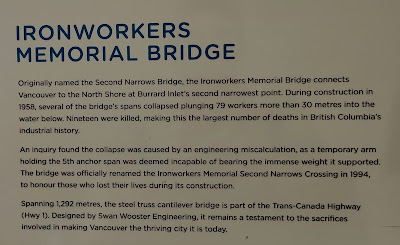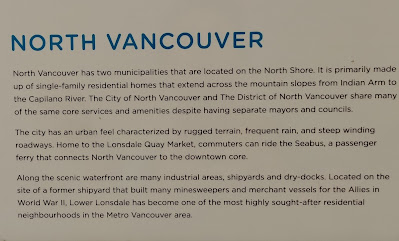Saturday, September 21, 2024
Vancouver, BC, Canada
 |
| There seemed to be a lot of interestingly shaped buildings in Vancouver. This one was right across the road from our room at the Coal Coast Harbour Hotel in downtown Vancouver. |
 |
| Horse-pulled tram rides. We had to follow one for a little while, very slowly. Wikipedia has some great information on Stanley Park. Interesting history. |
 |
| Our bus dropped us by the totem poles. From here we got a view of downtown Vancouver. |
 |
| And cruise ships at Canada Place Cruise Port. |
 |
| If you have trouble reading any photo, double click on it to enlarge for reading. |
 |
| Next, we walked to a view of Vancouver Harbour. The above photo is of a display that labels the features in the photo. |
 |
| This is a photo I took of the view. |
 |
| Prospect Point Lighthouse is part of Stanley Park. |
 |
| Lions Gate Bridge |
 |
| There were a few informational panels by the gift shop. |
 |
| Our bus tour of Stanley Park only took us to a small portion of the park. |
 |
| We boarded the bus and continued our tour of Vancouver. The highway back into downtown is the only major artery across the narrows to West Vancouver on the north shore so it's a very busy road. |
 |
| Just one of the many interesting buildings in Vancouver, B.C. |
 |
| What a juxtaposition of a half-timbered look to a skyscraper in the back. |
 |
| As I mentioned before, there are a lot of interesting buildings in Vancouver. This one has two towers connected on an upper floor by a swimming pool with a glass bottom. |
 |
| Many routes in downtown Vancouver use electric trolley buses, including major streets like Granville Street and Robson Street. |
 |
| We went through Chinatown where the trees were hung with red decorations that looked like lanterns. |
 |
| The streetlights were pretty nifty. |
 |
| Our last stop is The Lookout. It is built on top of a skyscraper called Harbour Centre making it one of the tallest buildings in Vancouver. With a 360-degree view, we could see all of Vancouver. |
 |
| Signs along the ledge below the windows told us what section of the city we were seeing. |
 |
| Floating gas station for the boats. |
 |
| Hotel room key was very colorful. My family had VW buses as I was growing up, so it was interesting how many t-shirts and other references to them we saw around town. |
 |
| One of the hotel's advertised amenities are the toilets. |
 |
| Ours came with instructions and |
 |
| an operation panel. |
Subscribe to:
Posts (Atom)















































































